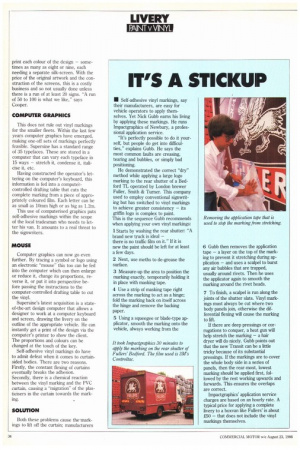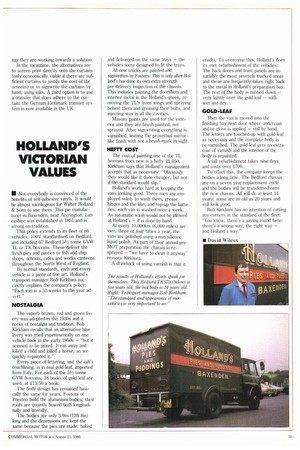THE VINYL SOLUTION
Page 35

Page 36

Page 37

If you've noticed an error in this article please click here to report it so we can fix it.
To paint or stick? That is the question facing operators trying to make the most of their liveries. CM examines the options.
• Thirty years ago, operators about to livery a new truck or van had to decide how to paint the vehicle. Nowadays, they have to decide if they are going to paint the vehicle.
It is the arrival of self-adhesive vinyl markings that has brought this new choice. Some people go so far as to say that traditional, skilled vehicle signwriters are fast becoming an endangered Species.
Self-adhesive markings are printed on. and cut from, vinyl film, of which there are two basic types; cast and calendered. With a cast film, the plastic ingredients are mixed with organic solvents to make a liquid which is then cast and cured to form the thin vinyl film.
Calendered films are manufactured without the solvents to a dough-like consistency which is kneaded into a rope and rolled out into a film.
ADHESIVE
This difference in their manufacture gives calendered and cast films different qualities when they are used for vehicle markings. The cast film is typically thinner (around 0.05-0.08mm, or 0.0020.003in), slightly more brittle and about 20% more expensive. A calendered film is usually thicker (around 0.08mm-0.1mm, or 0.003-0.004in) and stronger. Because it was pulled and rolled into shape rather than cast as a film, it has some inherent residual stress — commonly called its "memory" — which means that it has a tendency to regain its shape if stretched.
Cast films are more conformable and stand less proud of the vehicle's body, so they should have a longer life, despite the film itself being thinner and more brittle. The slightly cheaper and thicker calendered film can perform perfectly well on flat bodies and because it is stronger it can be peeled off in one piece more easily. This makes calendered films ideal for shirter life uses such as van rental fleets that want to remove the markings to sell the vans after a couple of years.
Manufacturers of both cast and calendered films offer various grades with life expectancies varying from two to seven years but in general cast films will offer the greater lingevity.
By changing the type of adhesive applied to the back of the vinyl film, the manufacturers can also instil different properties into the markings. For example, a low-tack adhesive applied to a calendered film makes an ideal short-life marking for promotional vehicles where a livery might be wanted for a few weeks; it would be cheap, easy to handle and simple to remove. There are also films that are designed to allow the marking to be repositioned during application to the vehicle, making the job less critical.
The two major manufacturers of vinyl films, 3M and Fasson, achieve this in different ways: 3M's Controltac has its main adhesive contained in minute glass beads so that the marking can be applied to the vehicle and re-positioned if necessary; then firmer pressure is applied to break the beads and release the adhesive.
CALENDERED Fasson's FasCal 1900 SST "repositional" film has an adhesive action that begins to accelerate only after you have had time to get the exact position for the marking.
Fasson and 3M are the two leading vinyl film manufacturers; there are many "converters" who buy the film to make the finished markings. Supersine of Lowestoft claims to be the largest independent converter. The eye-catching total-coverage self-adhesive markings on Benson & Hedges and Silk Cut lorries are among the well-known liveries pro duced by this company.
Supersine managing director Joan Cooper is naturally enthusiastic about the benefits of vinyl markings. She summarises their advantages over traditional painted songwriting: E Speed of application — even complex, complete vehicle liveries can be done in a few hours. The lorry never has to be off the road more than one day.
El Ease of application — "if you can wallpaper, you can do it," says Cooper. It can be applied in the operator's own yard.
0 Uniformity — every vehicle in the fleet will look identical: no singwriter can match this consistency.
0 Greater scope for the livery designer — there is virtually no limit to the artistic effects that can be achieved with vinyl film, including reflective markings which stand out at night.
El Durability — the best vinyl markings can outlive painted signwriting; alternatively they can be peeled off when no longer required. Lorries can become part of a current advertising campaign.
7 cost — difficult to compare like-forlike but vinyl should work out cheaper than painted signwriting.
In creating markings that use the more adventurous artwork or photographic halftones, the basis is normally a roll of plain white vinyl film. Supersine will screen print each colour of the design — sometimes as many as eight or nine, each needing a separate silk-screen. With the price of the original artwork and the construction of the screens, this is a costly business and so not usually done unless there is a run of at least 20 signs. "A run of 50 to 100 is what we like," says Cooper.
COMPUTER GRAPHICS This does not rule out vinyl markings for the smaller fleets. Within the last few years computer graphics have emerged, making one-off sets of markings perfectly feasible. Supersine has a standard range of 35 typefaces. These are stored in a computer that can vary each typeface in 15 ways — stretch it, condense it, italicise it, etc.
Having constructed the operator's lettering on the computer's keyboard, this information is fed into a computercontrolled drafting table that cuts the complete marking from a piece of appropriately coloured film. Each letter can be as small as lOmm high or as big as 1.2m.
This use of computerised graphics puts self-adhesive markings within the scope of the local tradesman who needs to letter his van. It amounts to a real threat to the signwriters.
MOUSE Computer graphics can now go even further. By tracing a symbol or logo using an electronic "mouse" this too can be fed into the computer which can then enlarge or reduce it, change its proportions, reverse it, or put it into perspective before passing the instructions to the computer-controlled drafting table to cut the vinyl.
Supersine's latest acquisition is a stateof-the-art design computer that allows a designer to work at a computer keyboard and screen, drawing the livery on the outline of the appropriate vehicle. He can instantly get a print of the design via the computer's printer to show the client. The proportions and colours can be changed at the touch of the key.
Self-adhesive vinyl markings do have to admit defeat when it comes to curtainsided bodies. There are two reasons. Firstly, the constant flexing of curtains eventually breaks the adhesion.
Secondly, there is a chemical reaction between the vinyl marking and the PVC curtain, causing a "migration" of the plasticisers in the curtain towards the marking.
SOLUTION Both these problems cause the.markings to lift off the curtain; manufacturers say they are working towards a solution.
In the meantime, the alternatives are to screen print directly onto the curtains (only economically viable if there are sufficient curtains to justify the cost of the screens) or to signwrite the curtains by hand, using inks. A third option is to use a transfer that does adhere to the curtain; the German Fleximark transfer system is now available in the UK_












































































